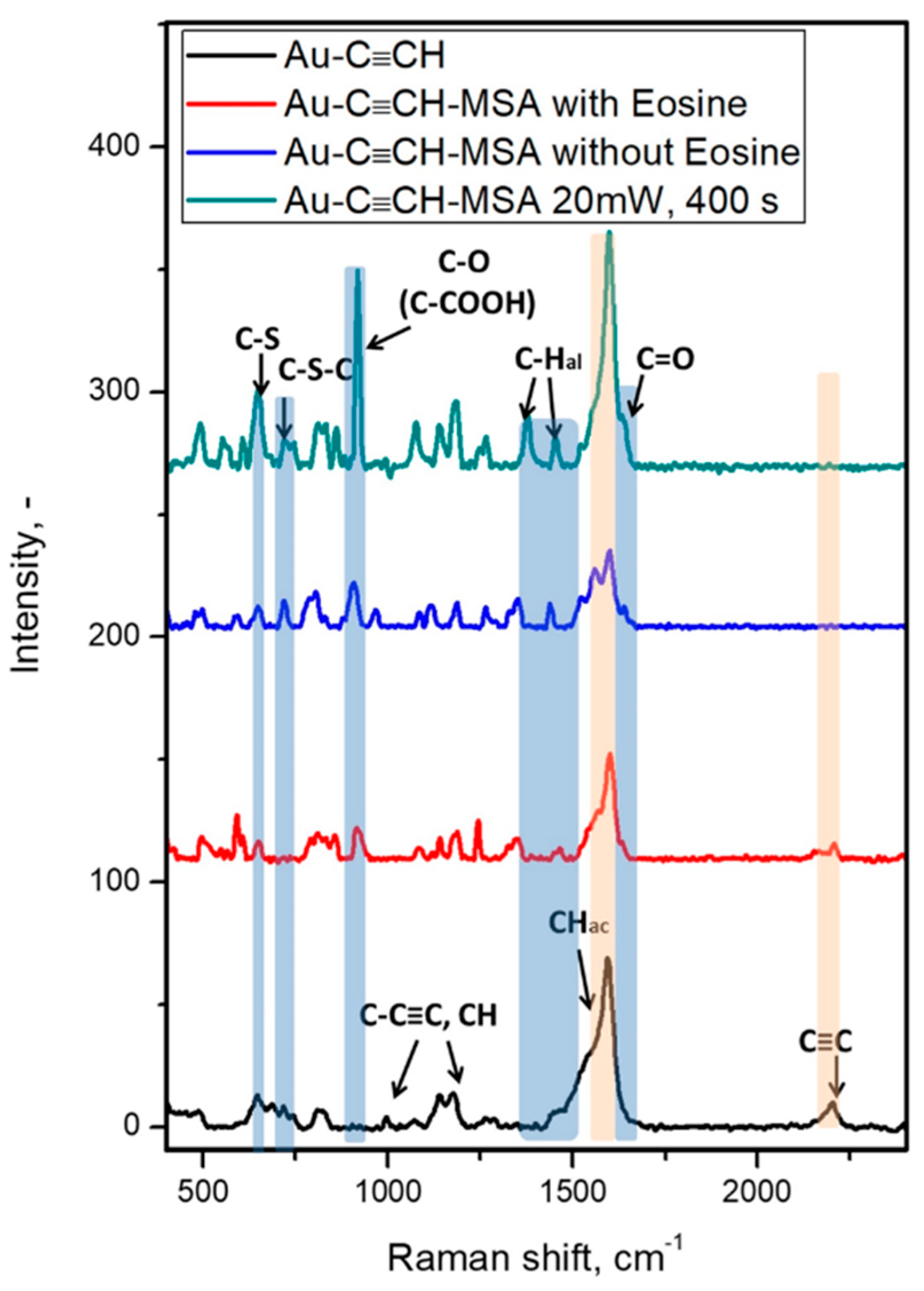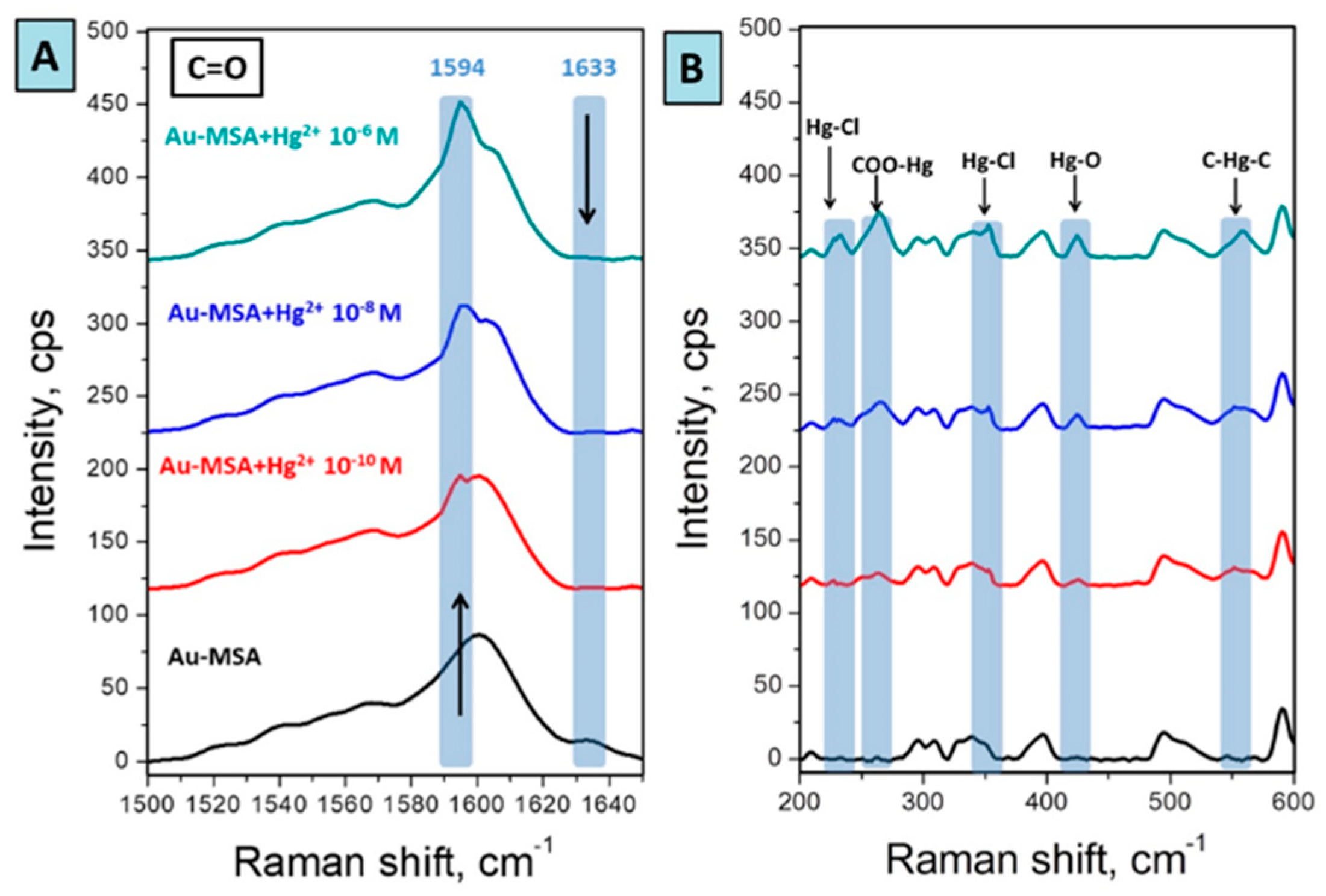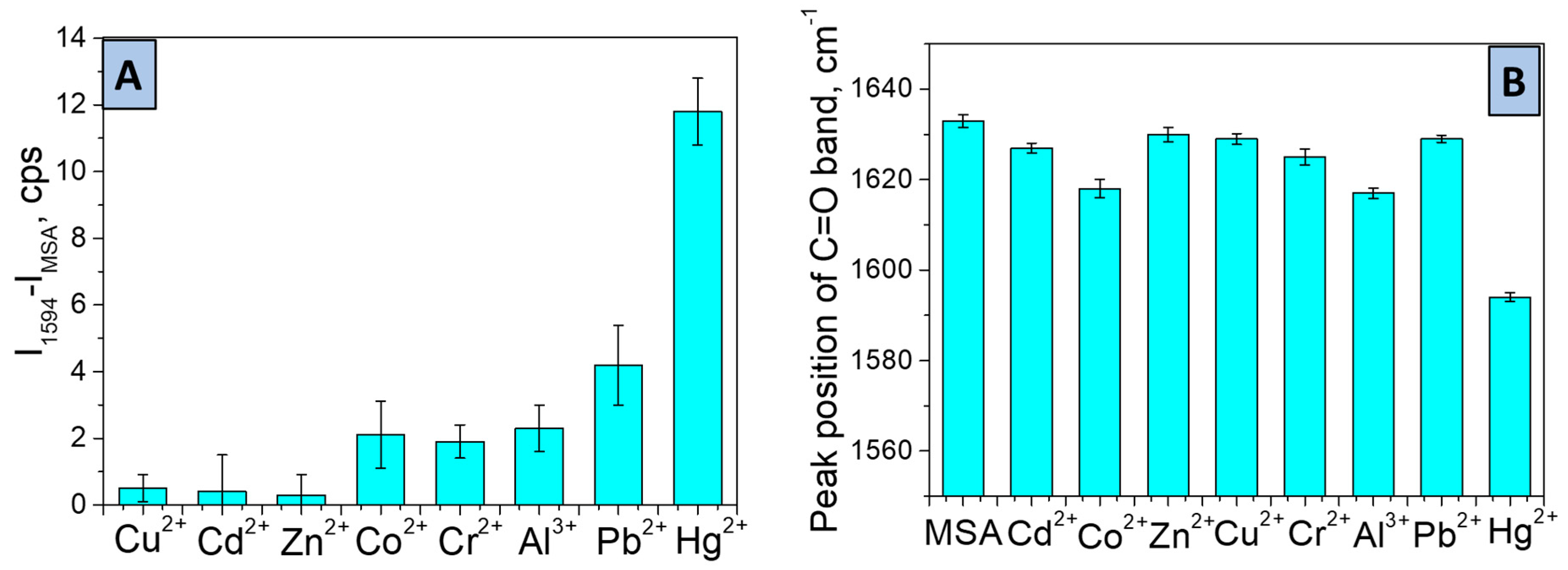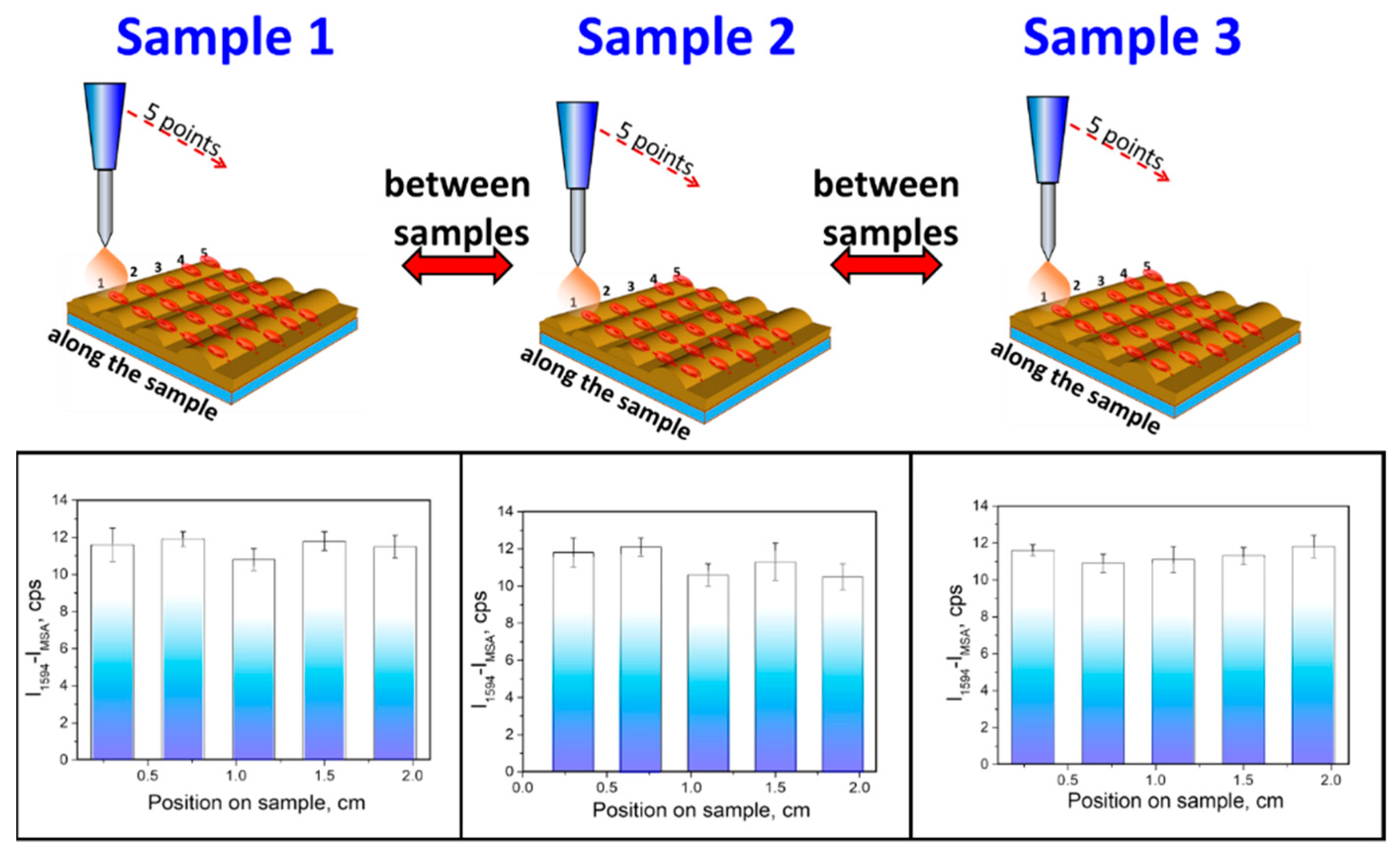Preparation of Selective and Reproducible SERS Sensors of Hg2+ Ions via a Sunlight-Induced Thiol–Yne Reaction on Gold Gratings
Abstract
1. Introduction
2. Materials and Methods
2.1. Materials
2.2. Sunlight Induced a Thiol–Yne Reaction between Ethynyl Groups and Mercaptosuccinic Acid
2.3. Measurement Techniques
2.4. Raman Spectroscopy Investigations—Complexation with Metal Ions
3. Results and Discussion
4. Conclusions
Supplementary Materials
Author Contributions
Funding
Conflicts of Interest
References
- Li, W.C.; Tse, H.F. Health Risk and Significance of Mercury in the Environment. Environ. Sci. Pollut. Res. 2015, 22, 192–201. [Google Scholar] [CrossRef]
- Liang, P.; Feng, X.; Zhang, C.; Zhang, J.; Cao, Y.; You, Q.; Leung, A.O.W.; Wong, M.-H.; Wu, S.-C. Human Exposure to Mercury in a Compact Fluorescent Lamp Manufacturing Area: By Food (Rice and Fish) Consumption and Occupational Exposure. Environ. Pollut. 2015, 198, 126–132. [Google Scholar] [CrossRef]
- Yassa, H.A. Autism: A Form of Lead and Mercury Toxicity. Environ. Toxicol. Pharmacol. 2014, 38, 1016–1024. [Google Scholar] [CrossRef]
- Walach, H.; Mutter, J.; Deth, R. Inorganic Mercury and Alzheimer’s Disease—Results of a Review and a Molecular Mechanism. Diet Nutr. Dement. Cogn. Decline 2015, 593–601. [Google Scholar] [CrossRef]
- Carocci, A.; Rovito, N.; Sinicropi, M.S.; Genchi, G. Mercury Toxicity and Neurodegenerative Effects. Rev. Environ. Contam. Toxicol. 2014, 229, 1–18. [Google Scholar] [CrossRef]
- Ha, E.; Basu, N.; Bose-O’Reilly, S.; Dórea, J.G.; McSorley, E.; Sakamoto, M.; Chan, H.M. Current Progress on Understanding the Impact of Mercury on Human Health. Environ. Res. 2017, 152, 419–433. [Google Scholar] [CrossRef]
- Lemos, V.A.; dos Santos, L.O. A New Method for Preconcentration and Determination of Mercury in Fish, Shellfish and Saliva by Cold Vapour Atomic Absorption Spectrometry. Food Chem. 2014, 149, 203–207. [Google Scholar] [CrossRef]
- Oliveira, E.P.; Yang, L.; Sturgeon, R.E.; Santelli, R.E.; Bezerra, M.A.; Willie, S.N.; Capilla, R. Determination of Trace Metals in High-Salinity Petroleum Produced Formation Water by Inductively Coupled Plasma Mass Spectrometry Following on-Line Analyte Separation/Preconcentration. J. Anal. At. Spectrom. 2011, 26, 578–585. [Google Scholar] [CrossRef]
- Campanella, B.; Onor, M.; Ulivo, A.D.; Giannarelli, S.; Bramanti, E. Impact of Protein Concentration on the Determination of Thiolic Groups of Ovalbumin: A Size Exclusion Chromatography–Chemical Vapor Generation–Atomic Fluorescence Spectrometry Study via Mercury Labeling. Anal. Chem. 2014, 86, 2251–2256. [Google Scholar] [CrossRef]
- Pietilä, H.; Perämäki, P.; Piispanen, J.; Majuri, L.; Starr, M.; Nieminen, T.; Kantola, M.; Ukonmaanaho, L. Determination of methyl mercury in humic-rich natural water samples using N2-distillation with isotope dilution and on-line purge and trap GC-ICP-MS. Microchem. J. 2014, 112, 113–118. [Google Scholar] [CrossRef]
- Zhang, Y.; Liu, Y.; Zhen, S.J.; Huang, C.Z. Graphene Oxide as an Efficient Signal-to-Background Enhancer for DNA Detection with a Long Range Resonance Energy Transfer Strategy. Chem. Commun. 2011, 47, 11718. [Google Scholar] [CrossRef] [PubMed]
- Guo, Y.; Zhang, Y.; Shao, H.; Wang, Z.; Wang, X.; Jiang, X. Label-Free Colorimetric Detection of Cadmium Ions in Rice Samples Using Gold Nanoparticles. Anal. Chem. 2014, 86, 8530–8534. [Google Scholar] [CrossRef] [PubMed]
- Chen, L.; Zhao, Y.; Wang, Y.; Zhang, Y.; Liu, Y.; Han, X.X.; Zhao, B.; Yang, J. Mercury Species Induced Frequency-Shift of Molecular Orientational Transformation Based on SERS. Analyst 2016, 141, 4782–4788. [Google Scholar] [CrossRef]
- Wang, Y.; Wen, G.; Ye, L.; Liang, A.; Jiang, Z. Label-Free SERS Study of Galvanic Replacement Reaction on Silver Nanorod Surface and Its Application to Detect Trace Mercury Ion. Sci. Rep. 2016, 6, 19650. [Google Scholar] [CrossRef] [PubMed]
- Guselnikova, O.; Postnikov, P.; Erzina, M.; Kalachyova, Y.; Švorčík, V.; Lyutakov, O. Pretreatment-Free Selective and Reproducible SERS-Based Detection of Heavy Metal Ions on DTPA Functionalized Plasmonic Platform. Sensors Actuators B Chem. 2017, 253, 830–838. [Google Scholar] [CrossRef]
- Li, M.; Cushing, S.K.; Wu, N. Plasmon-Enhanced Optical Sensors: A Review. Analyst 2015, 140, 386–406. [Google Scholar] [CrossRef] [PubMed]
- Fateixa, S.; Raposo, M.; Nogueira, H.I.S.; Trindade, T. A General Strategy to Prepare SERS Active Filter Membranes for Extraction and Detection of Pesticides in Water. Talanta 2018, 182, 558–566. [Google Scholar] [CrossRef] [PubMed]
- Zapata, F.; López-López, M.; García-Ruiz, C. Detection and Identification of Explosives by Surface Enhanced Raman Scattering. Appl. Spectrosc. Rev. 2016, 51, 227–262. [Google Scholar] [CrossRef]
- Akanny, E.; Bonhommé, A.; Bois, L.; Minot, S.; Bourgeois, S.; Bordes, C.; Bessueille, F. Development and Comparison of Surface-Enhanced Raman Scattering Gold Substrates for In Situ Characterization of ‘Model’ Analytes in Organic and Aqueous Media. Chem. Afr. 2019. [Google Scholar] [CrossRef]
- Yuan, Y.; Panwar, N.; Yap, S.H.K.; Wu, Q.; Zeng, S.; Xu, J.; Tjin, S.C.; Song, J.; Qu, J.; Yong, K.-T. SERS-Based Ultrasensitive Sensing Platform: An Insight into Design and Practical Applications. Coord. Chem. Rev. 2017, 337, 1–33. [Google Scholar] [CrossRef]
- Alvarez-Puebla, R.A.; Liz-Marzán, L.M. Traps and Cages for Universal SERS Detection. Chem. Soc. Rev. 2011, 41, 43–51. [Google Scholar] [CrossRef]
- Xu, L.; Yin, H.; Ma, W.; Kuang, H.; Wang, L.; Xu, C. Ultrasensitive SERS Detection of Mercury Based on the Assembled Gold Nanochains. Biosens. Bioelectron. 2015, 67, 472–476. [Google Scholar] [CrossRef]
- Senapati, T.; Senapati, D.; Singh, A.K.; Fan, Z.; Kanchanapally, R.; Ray, P.C. Highly Selective SERS Probe for Hg(Ii) Detection Using Tryptophan-Protected Popcorn Shaped Gold Nanoparticles. Chem. Commun. 2011, 47, 10326. [Google Scholar] [CrossRef] [PubMed]
- Han, D.; Lim, S.Y.; Kim, B.J.; Piao, L.; Chung, T.D. Mercury(Ii) Detection by SERS Based on a Single Gold Microshell. Chem. Commun. 2010, 46, 5587. [Google Scholar] [CrossRef] [PubMed]
- Zhang, L.; Chang, H.; Hirata, A.; Wu, H.; Xue, Q.-K.; Chen, M. Nanoporous Gold Based Optical Sensor for Sub-Ppt Detection of Mercury Ions. ACS Nano 2013, 7, 4595–4600. [Google Scholar] [CrossRef] [PubMed]
- Si, S.; Liang, W.; Sun, Y.; Huang, J.; Ma, W.; Liang, Z.; Bao, Q.; Jiang, L. Facile Fabrication of High-Density Sub-1-Nm Gaps from Au Nanoparticle Monolayers as Reproducible SERS Substrates. Adv. Funct. Mater. 2016, 26, 8137–8145. [Google Scholar] [CrossRef]
- Zhou, Q.; Kim, T. Review of Microfluidic Approaches for Surface-Enhanced Raman Scattering. Sensors Actuators B Chem. 2016, 227, 504–514. [Google Scholar] [CrossRef]
- Guselnikova, O.; Postnikov, P.; Kalachyova, Y.; Kolska, Z.; Libansky, M.; Zima, J.; Svorcik, V.; Lyutakov, O. Large-Scale, Ultrasensitive, Highly Reproducible and Reusable Smart SERS Platform Based on PNIPAm-Grafted Gold Grating. ChemNanoMat 2017, 3, 135–144. [Google Scholar] [CrossRef]
- Kalachyova, Y.; Mares, D.; Lyutakov, O.; Kostejn, M.; Lapcak, L.; Švorčík, V. Surface Plasmon Polaritons on Silver Gratings for Optimal SERS Response. J. Phys. Chem. C 2015, 119, 9506–9512. [Google Scholar] [CrossRef]
- Botasini, S.; Heijo, G.; Méndez, E. Toward Decentralized Analysis of Mercury (II) in Real Samples. A Critical Review on Nanotechnology-Based Methodologies. Anal. Chim. Acta 2013, 800, 1–11. [Google Scholar] [CrossRef]
- Kim, H.N.; Ren, W.X.; Kim, J.S.; Yoon, J. Fluorescent and Colorimetric Sensors for Detection of Lead, Cadmium, and Mercury Ions. Chem. Soc. Rev. 2012, 41, 3210–3244. [Google Scholar] [CrossRef]
- Li, L.; Zhang, Q.; Ding, Y.; Cai, X.; Gu, S.; Cao, Z. Application of l -Cysteine Capped Core–shell CdTe/ZnS Nanoparticles as a Fluorescence Probe for Cephalexin. Anal. Methods 2014, 6, 2715–2721. [Google Scholar] [CrossRef]
- Ma, Y.; Jiang, L.; Mei, Y.; Song, R.; Tian, D.; Huang, H. Colorimetric Sensing Strategy for Mercury(Ii) and Melamine Utilizing Cysteamine-Modified Gold Nanoparticles. Analyst 2013, 138, 5338. [Google Scholar] [CrossRef]
- Saikia, D.; Dutta, P.; Sarma, N.S.; Adhikary, N.C. CdTe/ZnS Core/Shell Quantum Dot-Based Ultrasensitive PET Sensor for Selective Detection of Hg (II) in Aqueous Media. Sensors Actuators B Chem. 2016, 230, 149–156. [Google Scholar] [CrossRef]
- Wen, G.; Wen, X.; Choi, M.M.F.; Shuang, S. Photoelectrochemical Sensor for Detecting Hg2+ Based on Exciton Trapping. Sensors Actuators B Chem. 2015, 221, 1449–1454. [Google Scholar] [CrossRef]
- Ke, J.; Li, X.; Zhao, Q.; Hou, Y.; Chen, J. Ultrasensitive Quantum Dot Fluorescence Quenching Assay for Selective Detection of Mercury Ions in Drinking Water. Sci. Rep. 2015, 4, 5624. [Google Scholar] [CrossRef]
- Priyadarshini, E.; Pradhan, N. Gold Nanoparticles as Efficient Sensors in Colorimetric Detection of Toxic Metal Ions: A Review. Sensors Actuators B Chem. 2017, 238, 888–902. [Google Scholar] [CrossRef]
- Escorihuela, J.; Marcelis, A.T.M.; Zuilhof, H. Metal-Free Click Chemistry Reactions on Surfaces. Adv. Mater. Interfaces 2015, 2, 1500135. [Google Scholar] [CrossRef]
- Lowe, A.B. Thiol-Ene “Click” Reactions and Recent Applications in Polymer and Materials Synthesis. Polym. Chem. 2010, 1, 17–36. [Google Scholar] [CrossRef]
- Bengamra, M.; Khlifi, A.; Ktari, N.; Mahouche-Chergui, S.; Carbonnier, B.; Fourati, N.; Kalfat, R.; Chehimi, M.M. Silanized Aryl Layers through Thiol-Yne Photo-Click Reaction. Langmuir 2015, 31, 10717–10724. [Google Scholar] [CrossRef]
- Zalesskiy, S.S.; Shlapakov, N.S.; Ananikov, V.P. Visible Light Mediated Metal-Free Thiol–yne Click Reaction. Chem. Sci. 2016, 7, 6740–6745. [Google Scholar] [CrossRef]
- Filimonov, V.D.; Trusova, M.; Postnikov, P.; Krasnokutskaya, E.A.; Lee, Y.M.; Hwang, H.Y.; Kim, H.; Chi, K.-W. Unusually Stable, Versatile, and Pure Arenediazonium Tosylates: Their Preparation, Structures, and Synthetic Applicability. Org. Lett. 2008, 10, 3961–3964. [Google Scholar] [CrossRef]
- Guselnikova, O.; Postnikov, P.; Chehimi, M.M.; Kalachyovaa, Y.; Svorcik, V.; Lyutakov, O. Surface Plasmon-Polariton: A Novel Way To Initiate Azide–Alkyne Cycloaddition. Langmuir 2019, 35, 2023–2032. [Google Scholar] [CrossRef]
- Guselnikova, O.; Postnikov, P.; Elashnikov, R.; Trusova, M.; Kalachyova, Y.; Libansky, M.; Barek, J.; Kolska, Z.; Švorčík, V.; Lyutakov, O. Surface Modification of Au and Ag Plasmonic Thin Films via Diazonium Chemistry: Evaluation of Structure and Properties. Colloids Surf. A Physicochem. Eng. Asp. 2017, 516, 274–285. [Google Scholar] [CrossRef]
- Gam-Derouich, S.; Lamouri, A.; Redeuilh, C.; Decorse, P.; Maurel, F.; Carbonnier, B.; Beyazıt, S.; Yilmaz, G.; Yagci, Y.; Chehimi, M.M. Diazonium Salt-Derived 4-(Dimethylamino)Phenyl Groups as Hydrogen Donors in Surface-Confined Radical Photopolymerization for Bioactive Poly(2-Hydroxyethyl Methacrylate) Grafts. Langmuir 2012, 28, 8035–8045. [Google Scholar] [CrossRef]
- Kalachyova, Y.; Erzina, M.; Postnikov, P.; Svorcik, V.; Lyutakov, O. Flexible SERS Substrate for Portable Raman Analysis of Biosamples. Appl. Surf. Sci. 2018, 458, 95–99. [Google Scholar] [CrossRef]
- Guselnikova, O.; Kalachyova, Y.; Hrobonova, K.; Trusova, M.; Barek, J.; Postnikov, P.; Svorcik, V.; Lyutakov, O. SERS Platform for Detection of Lipids and Disease Markers Prepared Using Modification of Plasmonic-Active Gold Gratings by Lipophilic Moieties. Sensors Actuators B Chem. 2018, 265, 182–192. [Google Scholar] [CrossRef]
- Guselnikova, O.; Postnikov, P.; Trelin, A.; Švorčík, V.; Lyutakov, O. Dual Mode Chip Enantioselective Express Discrimination of Chiral Amines via Wettability-Based Mobile Application and Portable Surface-Enhanced Raman Spectroscopy Measurements. ACS Sesnors 2019, 4, 1032–1039. [Google Scholar] [CrossRef]
- Ibrahim, M.; Haes, H.E. Computational Spectroscopic Study of Copper, Cadmium, Lead and Zinc Interactions in the Environment. Int. J. Environ. Pollut. 2005, 23, 417. [Google Scholar] [CrossRef]
- Sze, Y.K.; Davis, A.R.; Neville, G.A. Raman and infrared studies of complexes of mercury(II) with cysteine, cysteine methyl ester and methionine. Inorg. Chem. 1975, 14, 1969–1974. [Google Scholar] [CrossRef]
- Shindo, H.; Brown, T.L. Infrared Spectra of Complexes of L-Cysteine and Related Compounds with Zinc(II), Cadmium(II), Mercury(II), and Lead(II)1. J. Am. Chem. Soc. 1965, 87, 1904–1908. [Google Scholar] [CrossRef] [PubMed]
- United Nations Environment Programme. Summary of the Assessment Report. Global Mercury Assessment. Available online: https://wedocs.unep.org/bitstream/handle/20.500.11822/11517/UNEP_GlobalAtmosphericMercuryAssessment_May2009.pdf (accessed on 6 May 2019).
- Human Exposure. International Mercury Assessment. United Nations Environment Programme. Available online: https://blogs.iit.edu/global-leaders/files/2012/06/IMA-Assessment_Part-1.pdf (accessed on 6 May 2019).
- Ahmadivand, A.; Gerislioglu, B.; Manickam, P.; Kaushik, A.; Bhansali, S.; Nair, M.; Pala, N. Rapid Detection of Infectious Envelope Proteins by Magnetoplasmonic Toroidal Metasensors. ACS Sensors 2017, 2, 1359–1368. [Google Scholar] [CrossRef] [PubMed]








| Materials | Au | C | O | N | S |
|---|---|---|---|---|---|
| Au | 53.7 | 34.6 | 11.7 | - | - |
| Au-C≡CH | 14 | 48.2 | 32.5 | 5.3 | - |
| A-MSA | 2.5 | 53.2 | 39.8 | 1.3 | 3.2 |
© 2019 by the authors. Licensee MDPI, Basel, Switzerland. This article is an open access article distributed under the terms and conditions of the Creative Commons Attribution (CC BY) license (http://creativecommons.org/licenses/by/4.0/).
Share and Cite
Guselnikova, O.; Svorcik, V.; Lyutakov, O.; Chehimi, M.M.; Postnikov, P.S. Preparation of Selective and Reproducible SERS Sensors of Hg2+ Ions via a Sunlight-Induced Thiol–Yne Reaction on Gold Gratings. Sensors 2019, 19, 2110. https://doi.org/10.3390/s19092110
Guselnikova O, Svorcik V, Lyutakov O, Chehimi MM, Postnikov PS. Preparation of Selective and Reproducible SERS Sensors of Hg2+ Ions via a Sunlight-Induced Thiol–Yne Reaction on Gold Gratings. Sensors. 2019; 19(9):2110. https://doi.org/10.3390/s19092110
Chicago/Turabian StyleGuselnikova, Olga, Vaclav Svorcik, Oleksiy Lyutakov, Mohamed M. Chehimi, and Pavel S. Postnikov. 2019. "Preparation of Selective and Reproducible SERS Sensors of Hg2+ Ions via a Sunlight-Induced Thiol–Yne Reaction on Gold Gratings" Sensors 19, no. 9: 2110. https://doi.org/10.3390/s19092110
APA StyleGuselnikova, O., Svorcik, V., Lyutakov, O., Chehimi, M. M., & Postnikov, P. S. (2019). Preparation of Selective and Reproducible SERS Sensors of Hg2+ Ions via a Sunlight-Induced Thiol–Yne Reaction on Gold Gratings. Sensors, 19(9), 2110. https://doi.org/10.3390/s19092110






